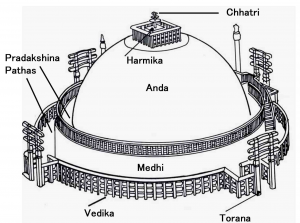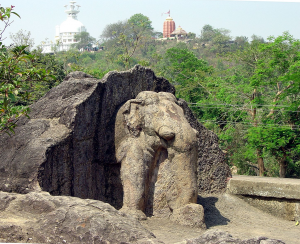


Areas of Interest: North India
NORTH INDIA
I. Political Background
The period from the sixth to the late fourth century BC witnessed the rise of territorial polities-mahajanapadas in North India. This culminated in the establishment of the Mauryan Empire in about 325 BC. The Mauryan Empire was a pan-Indian empire founded by Chandragupta Maurya.
Ashoka is considered the most significant ruler of the empire.
II. Literature and Language
The Mauryan era witnessed very few literary contributions. These contributions were either in Prakrit or Pali or Sanskrit.
1. Sanskrit
| Work | Author | Type | Theme | Patronage |
| Arthashastra | Chanakya | Political text written in Sanskrit | Deals with statecraft, Economic policy, military strategy and overall administration of the Mauryan realm. | Chandragupta Maurya |
2. Pali and Prakrit
The religious books of Buddhism and Jainism were written in Pali and Prakrit (the language of the masses) respectively. This ensured even common men read and understood religion.
The earliest Buddhist works were written in Pali. The Buddhist works can be divided into the canonical and the non-canonical.
The canonical literature is best represented by the “Tripitakas”, that is, three baskets – Vinaya Pitaka, Sutta Pitaka and Abhidhamma Pitaka.
| Work | Author | Type | Theme |
| Vinaya Pitaka | Upali | Buddhist scripture written in Pali. Name means basket of discipline. | Deals with monastic rules for monks and nuns. |
| Abhidhamma Pitaka | Buddhist scripture written in Pali | Deals with philosophy and metaphysics. | |
| Sutta Pitaka | Ananda | Pali collection of Buddhist writings of Thervada Buddhism | Deals with dialogues and discourses on morality and deals with Dharma. |
The non-canonical literature is best represented by the Jatakas. Jatakas are interesting stories of the previous births of Buddha. Each birth story is called a Jataka.
The Jain texts were written in Prakrit.
| Work | Author | Type | Theme |
| Kalpasutra | Bhadrabahu | Jain scripture. written in Prakrit. | Jain scripture. written in Prakrit. |
Besides these texts, Megasthenes’ Indica which was written in Greek also sheds light on the Mauryan administration.
III. Religion
Mauryan rulers were tolerant towards all religions.
1. Hinduism
Despite the increased popularity of Buddhism and Jainism, Hinduism remained popular too. Hinduism underwent changes during this era. Though Yajanas were performed animal sacrifices were stopped.
2. Buddhism
Buddhism flourished during Ashoka’s realm. He sent his son Mahinda and daughter Sangamitra to Sri Lanka to propagate Buddhism. Ashoka is also credited for the construction of 84000 stupas. Ashoka also convened the Third Buddhist Council.
History of Buddhist Council – These councils were Buddhist meetings held periodically which included Buddhist monks, nuns, and religious leaders.
| Buddhist Council | Timeline | Location | Outcome | Spiritual Leader (Monk) | Patronage |
| First Buddhist Council | Around 400 BC after Lord Buddha’s death. | Sattapanni caves, Rajgriha | Led to formulation of Sutta and Vinaya Pitaka. | Mahakasyapa | Ajatashatru |
| Second Buddhist Council | Around 383 BC | Vaishali | The aim was to settle the dispute on practices of Vinaya Pitaka which led to the first schism of Buddhism– Mahasamghikas and Sthaviravadins sects were formed. Sthaviravadins followed orthodox norms while Mahasamghikas followed less rigid norms. | Yasa | Kalasoka |
| Third Buddhist Council | Around 251 BC | Pātaliputra | Led to formulation of Abhidhamma Pitaka. | Moggaliputta Tissa | Ashoka |
| Fourth Buddhist Council | Around 72 AD | Kashmir | Buddhists further divided into 2 sects- Mahayana and Hinayana. | Vasumitra | Kanishka |
3. Jainism
The growing merchant community made religious grants to Jainism which ensured the religion prospered. Chandragupta Maurya became a Jain follower and sent missions to the South to propagate the religion further. The decline in animal sacrifices was a result of the increasing influence of Jainism and Buddhism.
IV. Architecture
For the first time, we see state-sponsored art and architecture. Architectures prior to this period seem to have been made of wood and hence were not able to survive. A case in point is the 80-pillared hall at Kumrahar which is often considered to be a Mauryan palace.
A. Stupas (click for more details)
For the first time, we see the construction of Stupas. These are hemispherical dome structures originally built over the relics of Buddha after his death. There were 8 of them distributed in places where Buddha seemed to have lived – Rajagraha, Vaishali, Kapilvastu, Allakapa, Ramagrama, Vethadipa, Pava, Kushinagar. Ashoka is credited to have commissioned construction of 84000 stupas.
The components of a Stupa are shown in the diagram –
B. Pillars and Capitals (click for more details)
After the Harappan period stone sculpting had disappeared. Its re-emergence is seen in Ashokan pillar and capitals.
Summary of sites where capitals have been discovered
| Crowning Animal | Site |
| Quadruple Lion | Sarnath |
| Single Lion | Basarah – Bakhira, Lauriya – Nandangarh, Rampurva, Vaishali |
| Elephant | Sankissa |
| Bull | Rampurva |
1. Sarnath, Uttar Pradesh
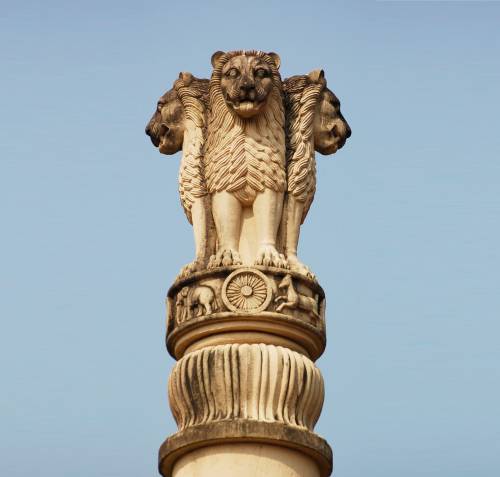
- Another remarkable sculpture is Sarnath’s lion capital
- Characterized by four Asiatic lions standing back to back
- It was adopted as India’s national emblem in 1950.
- Figures of horse, lion, bull and elephant are sculpted on the abacus.
- This pillar capital symbolized Dharmachakraparivartana that is the first sermon of Buddha.
- The abacus has four wheels with 24 spokes each. This wheel with 24 spokes is adopted in the National Flag.
1. Basarah – Bakhira, Bihar
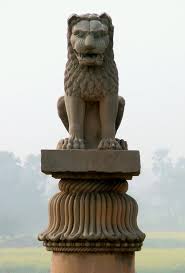
- Single crowning lion sitting on a square abacus.
- Compared to other capitals, this sculpture is relatively less ornamented.
2. Lauriya – Nandangarh Lion Capital
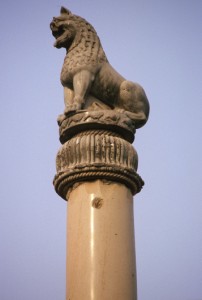
- In Champaran district of Bihar.
- The pillar is inscribed with edicts of Ashoka
- Characterized by round abacus and lion as the crowning animal.
3. Sankisa Elephant Capital
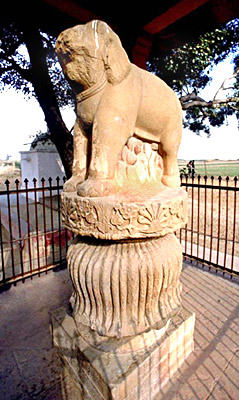
- Located in Uttar Pradesh
- After Buddha’s death Ashoka installed series of columns in Sankissa among them only the Elephant capital survives.
4. Rampurva, Bihar
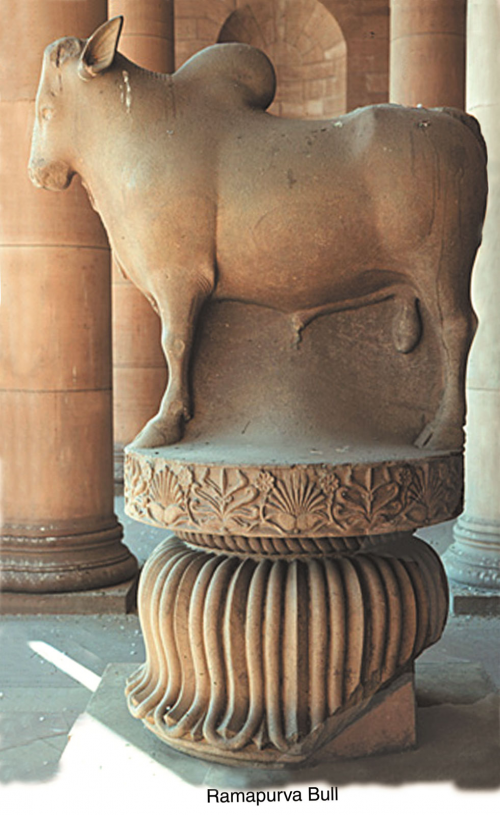
- Is a hybridization of Persian and Indian elements.
- The abacus shows Greek influence and has beautiful floral designs.
- Zebu bull is depicted as the crowning animal.
C. Temples
Evidence of the earliest known structural temples has been recovered through excavations at the Bairat District of Jaipur, Rajasthan.
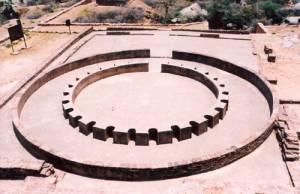
- This shrine is dated to the 3rd century B.C
- A circular brick and timber shrine of the Mauryan period
- Was made of lime-plastered brick work
- Points to construction of wooden pillars.
- Surrounded by a seven feet wide ambulatory.
Temple 40′ at Sanchi, has a similar plan, it was a stone temple on an apsidal plan enclosed by an ambulatory, and raised on a high, rectangular scale, approached by two flights of steps from diagonally opposite sides. The super-structure was possibly built of wood, and has disappeared.
D. Caves
Many caves were built during the time of Ashoka. They were mostly Chaityas and Viharas (click to read more)
1. BARABARA CAVES
- Oldest surviving rock-cut cave in India.
- These caves are situated in the twin hills of Barabar (four caves) and Nagarjuni (three caves) located in Bihar.
- These caves were granted to Ajivika sect by Ashoka. Ashokan inscriptions have been found in this cave.
- Caves are carved out of granite and have a polished surface.
- Barabar Hill contains four caves, namely, Karan Chaupar, Lomas Rishi, Sudama and Visva Zopri.
- Among these most important are Sudama and Lomas Rishi Caves as they are the earliest examples of rock-cut architecture in India
2. LOMAS RISHI CAVE
- The arch-like shape facade of Lomas Rishi Caves, imitates the contemporary timber architecture
3. SUDAMA CAVE
- This cave has better finishing in comparison to Lomas Rishi cave. The inner walls are highly polished.
V. Independent Art
Human figures are conspicuously absent. Exceptions to this pattern are the yaksha and yakshi sculptures.
A. Sculpture
Yaksha and Yakshi figures – Life-size figures have been found in Vidisha, Patna and Mathura.
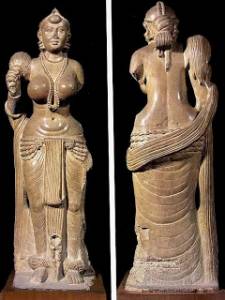
DIDARGANJ YAKSHI
- Found from a Didarganj, Patna.
- A wonderfully modeled life-size standing image of a Yakshini holding a chauri (flywhisk)
- Characterized by elaborate ornamentations and sensuous appeal depicting Indian sculptural tradition.
- Highly polished surface made up of sandstone.
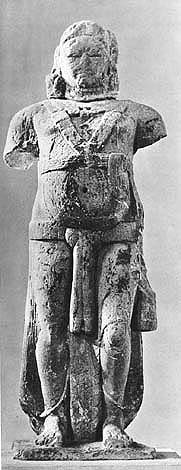
PAKHAM, YAKSHA
- Located in Mathura
- Made up of sandstone
Elephant in Dhauli, Orissa
- Dhauli Hills are located on the banks of river Daya south of Bhubaneshwar
- The oldest Buddhist sculpture in Orissa is the rock-cut elephant above which Ashokan Edicts are spotted.
Male Torso, Lohanipur
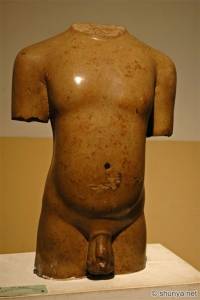
– Highly polished. The nude torso of a Jain Tirthankara or a savior of the Digambara sect found at Lohanipur
Additional Readings
- https://www.youtube.com/watch?v=Cz1413OZGb8
- https://www.asianart.com/articles/jaya/yakspar.html
- http://www.mapability.com/travel/p2i/barabar_4.php
- https://en.wikipedia.org/wiki/Dhauli
- http://www.bl.uk/onlinegallery/onlineex/apac/photocoll/s/019pho000001003u0330b000.html
- www.studyblue.com
- http://www.art-and-archaeology.com/india/dhauli/re01.html
